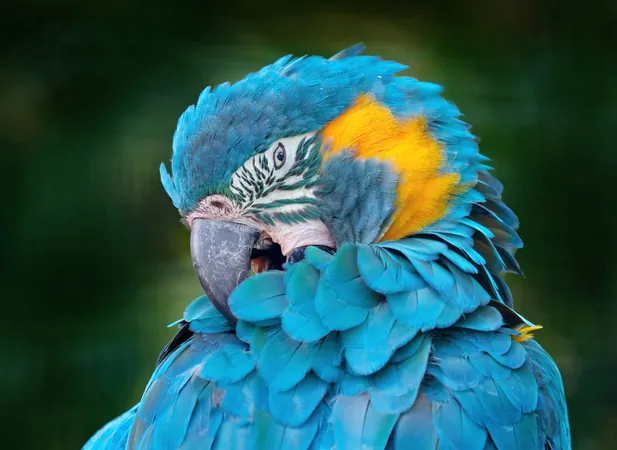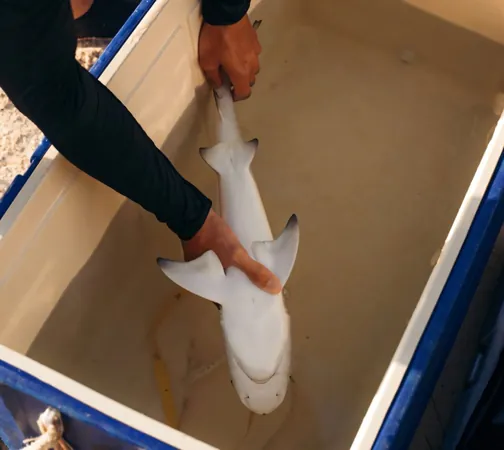
Blue-Throated Macaws Exhibit Surprising Human-Like Imitation Skills
2025-01-11
Author: John Tan
When we think of macaws or parrots, the term "copycat" often springs to mind. Renowned for their exceptional vocal mimicry, these vibrant birds not only mirror human speech but also other surrounding sounds with astonishing accuracy. However, a groundbreaking study has now revealed a captivating new dimension to their imitation prowess—movement.
Led by Dr. Esha Haldar from the Max Planck Institute for Biological Intelligence, in collaboration with the Loro Parque Fundación, this research focused on the critically endangered blue-throated macaw. Surprisingly, these remarkable birds demonstrate the ability to mimic physical actions as skillfully as they imitate sounds.
The researchers conducted experiments to test the macaws’ imitation of intransitive actions—movements that lack a physical object or predetermined outcome. Previously, such mimicry was regarded as a uniquely human trait.
Imitation: The Core of Cultural Evolution
The ability to imitate intransitive actions is fundamental to human cultural evolution, allowing the transmission of technical skills and the adoption of cultural norms. While there have been indications of automatic imitation in animals like dogs and budgerigars, these instances were limited to actions involving objects. This study provides the first evidence of automatic imitation of purely physical movements in non-human species, expanding our understanding of how social behaviors evolve.
Research Findings on Macaw Imitation Skills
In the study, the researchers trained the blue-throated macaws to perform specific actions—“lift leg” and “spread wings”—in response to hand signals. The birds were then divided into two experimental groups to evaluate their inclination to imitate.
In the “compatible” group, macaws received rewards for mimicking the actions of their peers. Conversely, those in the “incompatible” group could only earn rewards for performing opposite actions. The results were telling: the compatible group demonstrated a natural tendency to imitate, while the incompatible group found it difficult to resist the urge to copy, making more errors and taking longer to respond.
The Role of Mirror Neurons
Dr. Haldar expressed excitement about the findings, stating, “This study showcases, for the first time, non-human animals involuntarily imitating intransitive actions.” In humans, this behavior is often tied to mirror neurons—brain cells that activate during both the observation and execution of actions.
While this research does not definitively indicate that macaws possess mirror neurons, their instinctual mimicry suggests similar neural mechanisms might underlie these advanced imitation abilities.
Implications for Conservation
Dr. Auguste von Bayern from the Max Planck Institute highlighted the social implications of this behavior, suggesting that automatic imitation could improve social integration within groups and aid in the transmission of group-specific behaviors. This capability has far-reaching effects for conservation efforts, particularly for blue-throated macaws, whose numbers have dwindled to just around 350 in the wild.
Reintroduction projects could leverage the macaw’s mimicry skills, potentially allowing captive-bred birds to learn vital survival behaviors from their wild counterparts upon release.
A New Era for Macaw Conservation
The Loro Parque Fundación has invested over $2 million in the protection of these magnificent birds, successfully breeding 465 in captivity. This latest research adds a significant layer to their conservation strategy, paving the way for innovative approaches to ensure the survival of the blue-throated macaw.
Overall, these findings not only showcase the cognitive brilliance of macaws but also highlight their remarkable social and cultural parallels to humans. As we deepen our understanding of these fascinating creatures, we unlock new avenues for conservation and education in evolutionary biology.
Stay informed and inspired by following the latest developments in wildlife conservation and animal behavior research!





 Brasil (PT)
Brasil (PT)
 Canada (EN)
Canada (EN)
 Chile (ES)
Chile (ES)
 Česko (CS)
Česko (CS)
 대한민국 (KO)
대한민국 (KO)
 España (ES)
España (ES)
 France (FR)
France (FR)
 Hong Kong (EN)
Hong Kong (EN)
 Italia (IT)
Italia (IT)
 日本 (JA)
日本 (JA)
 Magyarország (HU)
Magyarország (HU)
 Norge (NO)
Norge (NO)
 Polska (PL)
Polska (PL)
 Schweiz (DE)
Schweiz (DE)
 Singapore (EN)
Singapore (EN)
 Sverige (SV)
Sverige (SV)
 Suomi (FI)
Suomi (FI)
 Türkiye (TR)
Türkiye (TR)
 الإمارات العربية المتحدة (AR)
الإمارات العربية المتحدة (AR)